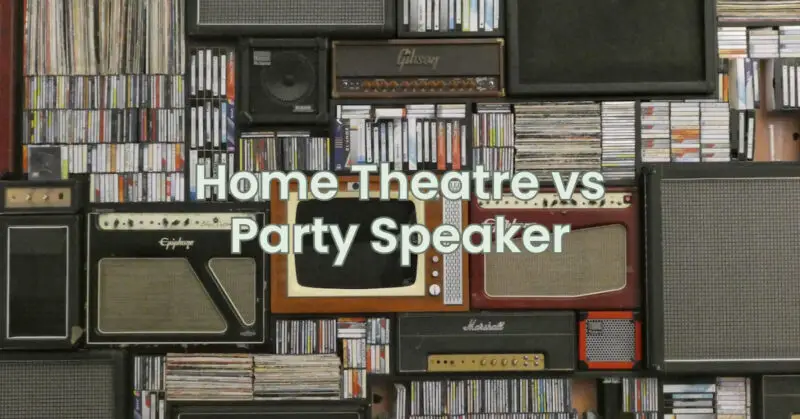When it comes to setting the mood and entertaining a crowd, two popular options for audio systems are home theatre setups and party speakers. While both aim to provide an enjoyable audio experience, they are designed for different purposes and environments. In this article, we will compare home theatre systems and party speakers to help you understand their distinctions and choose the right audio solution for your entertainment needs.
Home Theatre Systems: Home theatre systems are designed to recreate a cinematic audio experience in the comfort of your own home. They consist of a combination of speakers, audio/video (AV) receivers, and other components. Here are key points to understand about home theatre systems:
- Immersive Audio Experience: Home theatre systems aim to provide an immersive audio experience, replicating the sound effects and spatial dimensions of a movie theatre. They are designed to create an enveloping soundstage that enhances movie-watching experiences.
- Surround Sound Reproduction: Home theatre systems incorporate multiple speakers strategically placed around the room to create surround sound. This includes front speakers (left, center, and right), surround speakers, and a subwoofer to provide an immersive audio experience.
- AV Receiver and Processing: Home theatre systems utilize an AV receiver as the central hub for audio and video signals. AV receivers decode and process audio formats, such as Dolby Atmos or DTS:X, which enable immersive surround sound experiences. They also provide connectivity options for various source components and video displays.
- Dedicated Entertainment Space: Home theatre systems are typically installed in dedicated home theatre rooms or living spaces designed for optimal audio and visual experiences. They are geared towards recreating a cinema-like environment and are capable of delivering dynamic sound reproduction with precise positioning and effects.
Party Speakers: Party speakers are designed to create a lively and energetic atmosphere for social gatherings, parties, or events. They are built to deliver powerful audio output and often feature additional features for party entertainment. Here are key points to understand about party speakers:
- Portability and Power: Party speakers are designed to be portable, allowing you to take the party anywhere. They often feature built-in handles or wheels for easy transportation. These speakers prioritize powerful sound output and high volume levels to energize the crowd and fill larger spaces.
- Bluetooth and Connectivity: Party speakers typically offer wireless connectivity options such as Bluetooth, enabling seamless streaming of music from smartphones, tablets, or other compatible devices. They may also include additional connectivity options like USB ports, auxiliary inputs, or even built-in media players.
- Lighting and Effects: Party speakers often come equipped with built-in LED lights or other lighting effects to create a vibrant visual display that syncs with the music. Some party speakers may also include features like karaoke functionality, microphone inputs, or DJ effects to enhance the party experience.
- Crowd Engagement: Party speakers focus on delivering a fun and energetic audio experience for a larger audience. They prioritize sound dispersion and wide coverage, aiming to keep the crowd engaged and entertained with lively music and enhanced bass response.
Different Environments, Specific Functions: While home theatre systems and party speakers are both audio solutions, they serve different purposes and environments. Here’s how they differ:
- Immersion vs. Energy: Home theatre systems aim to create an immersive audio experience for movies and TV shows, focusing on sound precision and spatial effects. Party speakers prioritize high volume levels, powerful bass, and energetic sound to energize a crowd during social gatherings or parties.
- Space and Portability: Home theatre systems are designed for dedicated home entertainment spaces and are less portable. Party speakers offer portability, allowing you to take the music wherever you go and fill larger spaces with sound.
- Multi-Channel vs. Single Unit: Home theatre systems consist of multiple speakers, offering surround sound and precise audio positioning. Party speakers are self-contained units that typically feature a single enclosure with multiple drivers, delivering powerful sound in a compact package.
- Additional Features: Party speakers often incorporate features like LED lights, karaoke functionality, microphone inputs, and DJ effects to enhance the party atmosphere. Home theatre systems prioritize audio quality and may offer advanced audio processing technologies.
Conclusion: Home theatre systems and party speakers are designed for different environments and functions. Home theatre systems create an immersive audio experience for movies and TV shows, focusing on precision, spatial effects, and dedicated home entertainment spaces. Party speakers prioritize energetic sound, portability, and crowd engagement, making them ideal for social gatherings, parties, and events. Understanding the distinctions between these audio solutions will help you choose the right system that aligns with your entertainment needs and provides an enjoyable audio experience in the intended setting.


